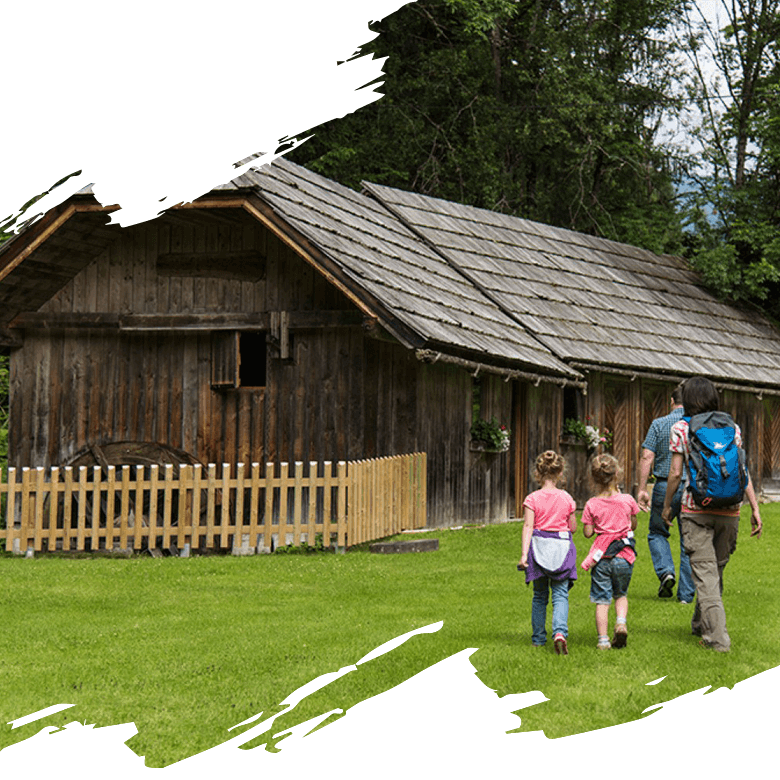
NOCKBERGE
ROUTE TO THE MILLS

Tourdates
Walking time without breaks: 1 hour
Altitude difference: 150 m
Total length: 4 Km
Difficulty: very easy circular hike
Tourist offices Sirnitz
+43 4279 240 12
The mill circuit starts in the historic centre of Deutsch-Griffen, a valley section between Pöckstein and the Reichenau plain. With Jonas, our youngest, we want to learn more about the work of millers and bakers in earlier times. Cereal cultivation has a long tradition in the Gurktal and extended into the 1950s. There were once around 65 mills in the immediate vicinity, and we will take a look at two of them today.
ON THE MILL HIKING TRAIL
We follow the markings "Mühlenwanderweg" and after about 20 minutes we reach the Hofbauer farm a little above Deutsch-Griffen. A few cows graze comfortably in the shade of the trees. We approach the murmur of the Arlsdorfbach stream, on the banks of which stands the Hofbauer mill. We are lucky: the stream has plenty of water this summer. There are also times when the stream flows only as a thin trickle, it then has to be dammed up so that the mill wheel can turn. Today, however, the mill still stands still. Only rarely is it still in operation. I explain to Jonas that a family with four children found shelter here in the narrow rooms of the mill during the war years. When the mill was washed away due to storms in the post-war years. Much later, one of the children who had lived here rebuilt the mill with his friends. Today it serves as a museum and reminds us of those times when the farmers still ground the grain they grew themselves.
THE PARISH CHURCH OF ST. JAKOBUS
Continuing along the forest path, there are always beautiful views down into the valley. Looking through the valley, we see the "Haidner-Höhe", the local mountain of Deutsch-Griffen, in the background. On its flanks are the Hochrindl on the left and the Flattnitz on the right. A special eye-catcher is the parish church of St. James. It rises on a mountain nose that reaches into the Griffnertal valley. With its massive defence wall, the church forms a fortress that towers impressively over the village. A special feature of the Deutsch-Griffner church is the covered staircase with more than 200 steps, visible from afar.
THE RAFFEL MILL - FAR FROM BEING EXHAUSTED
Soon we are going comfortably downhill, we cross the main road and reach the Raffelwirt. Here we meet Helmut Allesch. He rebuilt his house a few years ago and made an old water mill functional again. "Come with me" says Helmut and with a quick wave of his hand he takes us to a little wooden house right next to the Griffnerbach stream. Helmut is very proud of his mill, which he still uses to grind organic grain and bake bread for his guests. "Unlike back then," he explains, "today the mill is run by an undershot water wheel, i.e. by the flow of electricity from below." This is particularly suitable for demonstration purposes and he already asks Jonas to fill a sack of grain into the feed hopper, the so-called Goßen.
The clacking, grinding sound of the millstones pervades the tiny house. The upper millstone rotates slowly and grates the grain between the runner stone and the bottom stone according to the old tradition. Helmut catches the grist in a bag and fills it again into the grinder. He repeats the process up to four times until the flour is very fine and sifted through a flour bag. It can now be used for baking bread.
To our happy surprise, Hannelore Allesch serves us a delicious loaf of bread fresh from the oven with butter and salt at the end. It is very crispy and warm and we enjoy every bite. How easy it is to get bread from the baker these days! The way back takes us about a kilometre along the main road back to our starting point.
THE MILL RATTLES
In the Nockberge mountains, the Mühlenrundweg invites you to a lovely hike through a beautiful side valley of the Gurk valley, past idyllic power spots and to dreamlike vantage points.





